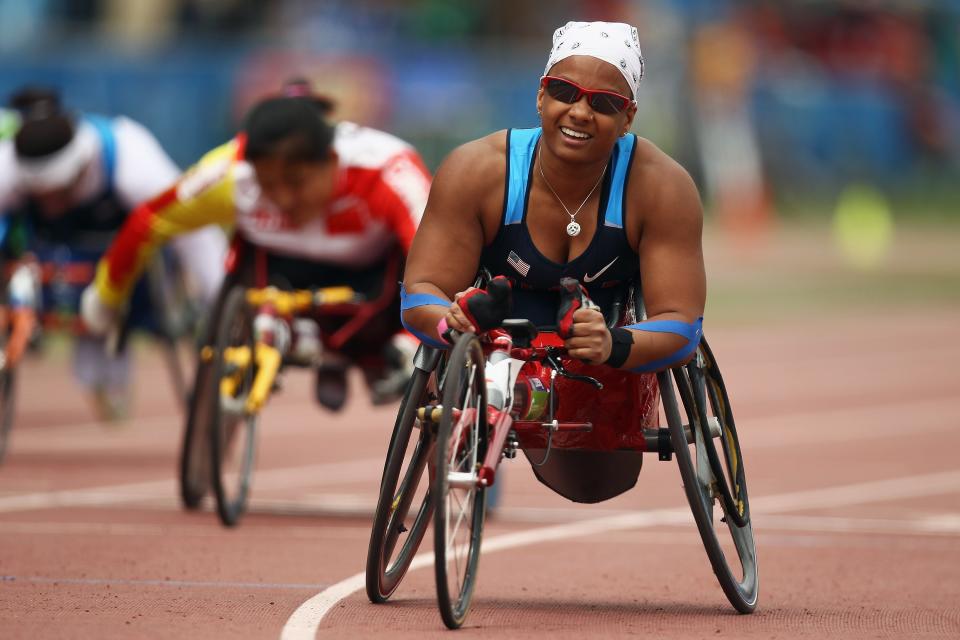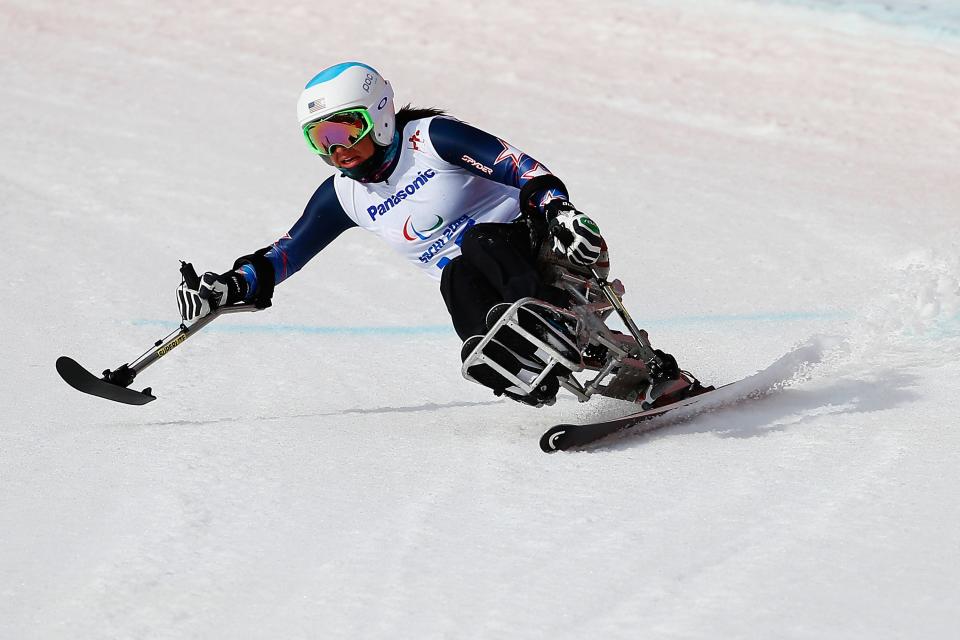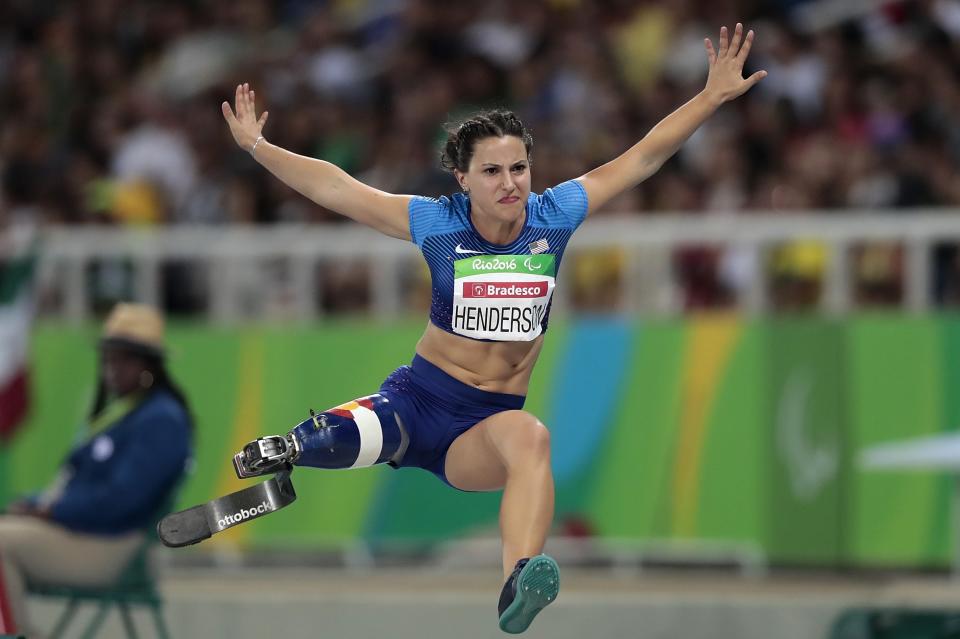The Path Out of Sport Isn’t Always Clear for Retiring Paralympians

picture alliance/Getty Images
Wheelchair racer and Paralympic bronze medalist Anjali Forber-Pratt was coping with major lower back pain before the 2012 London Paralympics. She knew she needed lumbar fusion surgery, but she had put it off until after competing, instead going for monthly injections as a temporary fix. Eleven days after the Games, she was in the operating room.
She expected to recover and return to training for the 2016 Rio Paralympics. Instead, due to underlying complications that initially stumped her doctors, she became quadriplegic, meaning paralysis now affected all her limbs. She had already lost the use of her legs due to a virus called transverse myelitis as a child.
It took 11 months, and several more surgeries, to resolve the complications. Her main goal was to regain feeling in her arm to perform daily tasks; returning to her racing chair was impossible for the foreseeable future. After a lifelong love of movement and a five-year elite athletic career, Forber-Pratt was left reeling.
“It was a form of grief, having the sudden loss of this thing that was such a part of everything that I was doing,” she tells SELF. Then there was what she describes as the “chaos” of managing both her medical issues and the logistics of what would come next: “There was a lot of worry, anxiety, and uncertainty.”
Her plans for the next four years evaporated, leaving her scrambling for a source of income and health insurance. (Fortunately, she says, the US Olympic and Paralympic Committee allowed her to take medical leave to keep her athlete insurance until she found a job with benefits.)
And as she faced all this stress, she was robbed of her primary coping mechanism. “Whenever things were in disarray in my life, I always went back to sport,” Forber-Pratt says. “But this time, it just felt like it was the opposite…I just felt like I needed to get away.”
Retirement is hard for any athlete, but Paralympians face unique challenges.
As Paralympic sports have become more prominent and prestigious, it’s sometimes possible for athletes to make them their full-time gig, Sarah Reinertsen, a retired Ironman triathlete and Paralympic runner who works in sports marketing at Nike, tells SELF. But athletic careers don’t typically last a lifetime, meaning both full- and part-time Paralympians will eventually face a major turning point: They’ll need to find something to take the place of competitive sport.
“We hear the success stories where athletes have been able to make that transition successfully and land in a great career,” Cheri Blauwet, MD, told reporters at a Nike event in Paris in September. She’s one of them: Dr. Blauwet is a seven-time Paralympic medalist who went to medical school while competing, and who is now a sports medicine specialist at Brigham and Women’s Hospital. “But the reality is that transition is difficult. We have good research and data to show that when athletes go through that transition, it can be a pretty tough time in life. The risk of mental health symptoms increases just because athletes are thinking, This was my identity—what is my identity now and what is it going to be moving forward?”
For Paralympians and Olympians alike, negative retirement experiences can tank well-being, per a study published earlier this year in BMJ Open Sport & Exercise Medicine. This could mean significant mental health struggles: According to a 2020 study in the journal Qualitative Research in Sport, between 18% and 39% of athletes have symptoms of anxiety and depression during retirement. For many, it’s temporary—but for one in five, the struggle to adjust lingers for two years or longer.
“You go from feeling like everybody’s watching you to no longer being the focus,” Aaron Scheidies, a retired Paralympic cyclist and triathlete, tells SELF. “Understanding and being okay with that, I think, is the biggest challenge.”
Any athlete can face that major shift, but Paralympians also deal with unique issues, as one of the few studies to focus on their experiences points out. While they’re competing, their expenses are high and compensation low, which may leave them struggling financially as they contemplate what’s next. They may also worry about what a new career might look like, research suggests: There are fewer opportunities in sports-adjacent fields—say, coaching, managing, or broadcasting—for Paralympians as compared to Olympians. (In fact, Paris marked the first time a Paralympian joined the NBC broadcast team to host in-person at the Games.)
Then there’s the disconnect between how disability is viewed within parasports versus ableism in the wider world. Paralympians are increasingly recognized—rightly so—as elite athletes. Retirement means going from that space into one which unfortunately often views disability as a medical problem, Amanda Leibovitz, PhD, a licensed therapist and certified mental performance consultant at Epic Wellness & Performance in Bellingham, Washington, tells SELF.
What’s more, sports are often the main way they connect to others with disabilities, so when it’s time to move on, they can feel isolated, Jamie Shapiro, PhD, a professor of sport and performance psychology at the University of Denver who consults with Paralympic athletes, tells SELF.
That was the case for Forber-Pratt. For the first year following retirement, she remained in Champaign, Illinois, where she lived while competing for the University of Illinois in its wheelchair track and field program and earning her PhD in human resources development. But to no longer have the bond of sport there was an adjustment. “It was really hard to be in Champaign and to not be on the wheelchair racing team,” she says, noting that while she doesn’t blame them, her former college teammates didn’t quite know how to support her. Then she relocated to Kansas for a job, which posed its own challenges. “It was also hard to up and move to a new state and to not have that community at all.”

IPC World Championships - Day 4
Then there’s the unacceptable reality that outside what some call the Paralympic “bubble,” misconceptions about the capabilities of people with disabilities and lack of accessibility limit future opportunities. While it’s illegal for employers to discriminate, government statistics show unemployment rates are about twice as high among people with disabilities as those without (7.2% versus 3.5% in 2023, according to the US Bureau of Labor Statistics).
“There’s this idea of going back to a world specifically, if you’re disabled, that does not have interest in your disability, is not making space for you, does not see you as valuable, does not see you contributing,” Lacey Henderson, CPMC, a retired Paralympic long jumper and current performance psychology professional, who earned her master’s degree in sport and performance psychology while still competing, tells SELF. “I can see why a lot of Paralympians stay [in sport] as long as possible.”
When life after sport looks hazy, some Paralympians are hesitant to make the retirement call.
Wheelchair basketball player and alpine skier Alana Nichols, the first American woman to win gold at the Summer and Winter Paralympics, took several years to retire. A series of injuries—including a dramatic crash during the super-G in Sochi in 2014, the day after she won a silver medal in downhill skiing—led her to take a break from the slopes.
She eventually gave skiing one last try, attempting to make the 2018 Winter Games. In part, she wanted to finish on better terms. But, she realizes in retrospect, her uncertainty about the future played a role: “I feel like my decision to go back was really based on, ‘I don’t know what to do now without competing,’” she tells SELF.
Her road to Pyeongchang 2018 came to an abrupt end when she crashed again two days before the final qualifying event, sustaining a serious concussion. That was her sign to move on for good. “I remember just knowing, even though it was still a hard decision, that I wanted to open the next chapter of my life,” she says.

2014 Paralympic Winter Games - Day 1
Exactly what that would entail wasn’t clear. She earned a bachelor’s and master’s degree while playing collegiate wheelchair basketball but didn’t feel suited for a corporate career. Nor was she interested in starting a nonprofit of some sort—a fairly common path for Paralympians, but one that essentially means running a small business. Her transition was “a really uncomfortable space” with lots of unknowns: “It was a constant time of reminding myself, ‘I am ready. I want to move on,’” she says.
The decision was similarly drawn-out for Henderson: The challenging feelings around retirement began a few years before she finally stepped away. More than a decade of training and competing left her fatigued, as well as frustrated with the sport’s shortcomings and bureaucracy—for instance, as she describes it, suboptimal competition venues and unclear criteria for making national and Paralympic teams.
“I would get done competing, and I would just sob,” Henderson says. “I could just feel my body be like, ‘I do not want to do this.’” Missing the joy she’d once found in sport, she finally emailed US Paralympics Track & Field in January of 2023 to notify them of her retirement.
Charting a path forward involves shaping a new identity—and dealing with all the emotions that come with it.
Perhaps the biggest challenge for retiring athletes is to “untangle” who they are outside of their sport while still keeping the things “that you really admire about yourself,” as Henderson explains.
For Forber-Pratt, that reimagining was tricky. Sport was what first allowed her to connect with other disabled people, and she honed her athletic identity from an early age. She grew up in Natick, Massachusetts, within walking distance of mile eight of the Boston Marathon course. As a child, she watched champion wheelchair racers like Jean Driscoll whiz by, and even dressed up as her for Halloween multiple years in a row.
“Sport was this freeing thing, where I was in control,” she says. “It was such a part of who I was for so long. It was so weird that it was just suddenly not.”
While Forber-Pratt has gone on to a successful career in academia, government, and nonprofits, fine-tuning her post-athlete path hasn’t been easy—or quick. “There was a chunk of time when I definitely was depressed and having a hard time processing it all,” she says. Two years after her retirement, she got emotional during the Winter Games in Sochi. “I remember watching the opening ceremony and it kind of hit me that, Oh my gosh, I’m not ever going to have that experience again.”
Working it out through therapy is key, says Henderson, who has also found that the process of adjusting to a new normal is ongoing. For instance, during the first week of the Paris Olympics, more than a year and a half after she retired from competitive sport, Henderson says she “cried a lot, for a lot of reasons.” Those included feeling overlooked and irrelevant, especially since the Paris Games seemed to be so much more celebrity-packed and buzzed-about than they were when she was an athlete.
Drawing on her sports psychology training, she notes that it’s common for retirement to unearth trauma that athletes have endured within their sport—like abusive coaching or injury—and also outside of it. An intense training and competition schedule means you may unintentionally push emotions aside, but facing them again later on “is a hard reckoning,” she says. That’s one reason the risk of anxiety, depression, and substance misuse increases for athletes around this time, a study in the journal PLOS One found.
For Nichols, the process of teasing out her new identity involved internal work like meditating and journaling. As she discovered, it still involved movement—just not in the all-encompassing way it had before.
After Nichols tried surfing in 2014, she realized she was drawn to the water. She began competing, and now that’s just one part of her multifaceted life; she’s also helping spearhead the movement to get adaptive surfing into the Paralympics, served as president of the Women’s Sports Foundation, traveled to Paris to be the host at the Team USA House at the Paralympics this year, and added the role of mom when she had a son, Gunnar, in 2019.
Henderson has also learned to be open-minded and flexible when new opportunities pop up outside her sport psychology path. Though she hadn’t considered broadcasting before, she jumped at the chance to become NBC’s first Paralympian to host in-person at the Paris Games. She wanted to tell athletes’ stories, from the perspective of someone with a disability.
In fact, many retiring athletes are drawn to staying involved in the Paralympic movement in some way. “You’ll hear some athletes say that sport saved their lives,” Dr. Shapiro says. “It had such a profound impact on their life that they want to give back, they want to help other youth or athletes with disabilities feel that same sense of belonging and accomplishment.”

2016 Rio Paralympics - Day 3
Having support during the retirement transition can be a big help, but prepping earlier is even better.
More organizations—and even corporations—have become aware of the need for programs to support Paralympians in their transition out of competitive sport. In conjunction with individual therapy, these can be helpful because they offer ways to help translate athletic skills into professional ones, as well as provide an opportunity for making connections and building community. “You’re not alone in going through this,” Forber-Pratt says.
Besides seeking therapy, Henderson also joined a USOPC program called Pivot. Retired or retiring athletes from both Olympic and Paralympic sports first attended a four-day retreat where they explored deep questions about identity and purpose and forged meaningful bonds. Afterward, they had monthly Zoom calls for six months, then created a WhatsApp text group, which they still use to check in with each other. “When you leave sport, you’re afraid that you’re going to be isolated and alone,” Henderson says. “But I think we all heal together.”
The USOPC also offers one-on-one career coaching, financial coaching, and mental health resources. Previously, some services were available only to competing athletes, and resources for Olympians and Paralympians were separated, Dr. Shapiro says. But now any member of Team USA can access psychological services for up to two years and other career-related benefits for up to 10 years post-retirement.
Certain corporations are also tailoring outreach to retiring Paralympians. During the Games, Nike announced it had partnered with the USOPC to launch GameOn, a yearlong career program at the company’s headquarters in Beaverton, Oregon. While it’s open to everyone, its focus is on disability inclusion, and Paralympians are encouraged to apply. In addition to traditional employment benefits, participants will receive education, mentorship, and professional development. “There needs to be a bridge between being on a field of play in sport and a corporate setting,” Vanessa Garcia-Brito, Nike’s chief impact officer, tells SELF. Applications opened on September 12, and the first cohort will start work on February 4, 2025.
Athletes and experts say targeted opportunities like these can be beneficial, provided Paralympians know about them. “Athletes need to be made aware of them earlier in their careers,” says Forber-Pratt. That way, they can have the time to think it through and steer their lives in the direction they want, rather than feeling like they have to take the first job available to them.
Building out a full, well-rounded life while still competing—i.e., treating sports as just one facet of their identity—can also both prepare athletes for the next phase and make them happier and healthier in the meantime, Dr. Leibovitz says. This can look like making and spending time with friends outside of sport, staying connected to family, going to school, or finding ways to engage with their communities.
When Dr. Leibovitz starts working with an athlete on their mental performance, she asks where they see themselves in 10 years and what possibilities they’ve considered after they achieve their goals in sport. The time may not be right to pursue another career or a family while competing, but it’s still worthwhile for athletes to know they might want these things someday. “If anything, it makes you invest even more in what you’re doing right now,” she says.
If Forber-Pratt could go back in time, she’d probably plan ahead more, she admits. But given the chance to talk to her younger self during the most trying moments, she’d offer words of reassurance: “It may not look the way you envision, but it is actually going to be okay.”
The biggest piece of advice Henderson gives other retiring Paralympians is to know that the journey may be a roller coaster, but ultimately the bumpiest parts will likely smooth out. “There’s no wrong way to feel,” Henderson says. “Feel the things that you’re feeling, and don’t stay in a place of self-judgment. It’s going to look and feel different for everybody, and it’s also a temporary part of your life until you resettle in a new foundation. There’s no wrong way to do it.”
Related:
Everything You Need to Know About the Paralympic Classifications
How 4 Pro Athletes Balance Parenthood With Big Olympic and Paralympic Dreams
If You’re Not Following the Perfectly Unserious Paralympics TikTok Account, You’re Missing Out
Get more of SELF’s great sports coverage delivered right to your inbox—for free.
Originally Appeared on SELF

 Yahoo Sports
Yahoo Sports 
